UHF Textronic RFID Transponder with Bead-Shaped Microelectronic Module
Abstract
:1. Introduction
1.1. Issue of RFID Tags in Garment Industry
1.2. Design of RFIDtex Transponder-Advancements
1.3. Design of RFIDtex Transponder Coupling System
1.4. Impact of Material Parameters on RFIDtex Tag Efficiency
2. Materials and Methods
3. Results—Simulations
3.1. One-Turn Coil in Microelectronic Module
3.2. Two-Turn Coil in Microelectronic Module
3.3. Two-Turn Coil in Enlarged Microelectronic Module
3.4. Length of Antenna Radiator
4. Experimental Results
4.1. General Assumption of Experiments
4.2. Experiment in Laboratory Stand
4.3. Experiment in Quasi-Real Conditions
5. Conclusions
Author Contributions
Funding
Institutional Review Board Statement
Informed Consent Statement
Data Availability Statement
Conflicts of Interest
References
- Finkenzeller, K. RFID Handbook—Fundamentals and Applications in Contactless Smart Cards. Radio Frequency Identification and Near-Field Communication, 3rd ed.; Wiley: Chichester, UK, 2010; ISBN 978-0-470-69506-7. [Google Scholar]
- Dobkin, D.M. The RF in RFID, 2nd ed.; Newnes: Oxford, UK, 2012; Volume 2nd, ISBN 0123945836. [Google Scholar]
- Jankowski-Mihułowicz, P.; Węglarski, M.; Chamera, M.; Pyt, P. Textronic UHF RFID Transponder. Sensors 2021, 21, 1093. [Google Scholar] [CrossRef] [PubMed]
- Van Langenhove, L.; Black, S.; Qin, Y.; Nierstrasz, V.A.; Pause, B.; Catrysse, M.; Pirotte, F.; Puers, R.; Van Langenhove, L.; Hertleer, C.; et al. Contributor Contact Details. In Smart Textiles for Medicine and Healthcare; Van Langenhove, L., Ed.; Woodhead Publishing Series in Textiles; Woodhead Publishing: Sawston, UK, 2007; pp. xi–xiii. ISBN 978-1-84569-027-4. [Google Scholar]
- Miozzi, C.; Amato, F.; Marrocco, G. Performance and Durability of Thread Antennas as Stretchable Epidermal UHF RFID Tags. IEEE J. Radio Freq. Identif. 2020, 4, 398–405. [Google Scholar] [CrossRef]
- Mohamadzade, B.; Hashmi, R.M.; Simorangkir, R.B.V.B.; Gharaei, R.; Ur Rehman, S.; Abbasi, Q.H. Recent Advances in Fabrication Methods for Flexible Antennas in Wearable Devices: State of the Art. Sensors 2019, 19, 2312. [Google Scholar] [CrossRef] [PubMed]
- Khan, Z.; Chen, X.; He, H.; Xu, J.; Wang, T.; Cheng, L.; Ukkonen, L.; Virkki, J. Glove-Integrated Passive UHF RFID Tags—Fabrication, Testing and Applications. IEEE J. Radio Freq. Identif. 2019, 3, 127–132. [Google Scholar] [CrossRef]
- Koski, K.; Sydanheimo, L.; Rahmat-Samii, Y.; Ukkonen, L. Fundamental Characteristics of Electro-Textiles in Wearable UHF RFID Patch Antennas for Body-Centric Sensing Systems. IEEE Trans. Antennas Propag. 2014, 62, 6454–6462. [Google Scholar] [CrossRef]
- Simorangkir, R.B.V.B.; Gawade, D.R.; Kumar, S.; O’Flynn, B.; Buckley, J.L.; Hannon, T.; Donovan, P.; Newberry, R. Screen printed epidermal antenna for IoT health monitoring. In Proceedings of the 2021 IEEE Asia-Pacific Microwave Conference (APMC), Brisbane, Australia, 28 November–1 December 2021; IEEE: New York, NY, USA, 2021; pp. 395–397. [Google Scholar]
- Jaakkola, K.; Sandberg, H.; Lahti, M.; Ermolov, V. Near-Field UHF RFID Transponder With a Screen-Printed Graphene Antenna. IEEE Trans. Compon. Packag. Manuf. Technol. 2019, 9, 616–623. [Google Scholar] [CrossRef]
- Casula, G.A. A design rule to reduce the human body effect on antennas for short range NF-UHF RFID systems. In Proceedings of the 2018 2nd URSI Atlantic Radio Science Meeting (AT-RASC), Gran Canaria, Spain, 28 May–1 June 2018; IEEE: New York, NY, USA, 2018; pp. 1–4. [Google Scholar]
- Radouchova, M.; Suchy, S.; Blecha, T. Embroidered flexible elastic textile antenna as strain sensor. In Proceedings of the 2022 45th International Spring Seminar on Electronics Technology (ISSE), Vienna, Austria, 11–15 May 2022; IEEE: New York, NY, USA, 2022; pp. 1–6. [Google Scholar]
- Bakkali, M.E.; Martinez-Estrada, M.; Fernandez-Garcia, R.; Gil, I.; Mrabet, O.E. Effect of bending on a textile UHF-RFID Tag Antenna. In Proceedings of the 2020 14th European Conference on Antennas and Propagation (EuCAP), Copenhagen, Denmark, 15–20 March 2020; IEEE: New York, NY, USA, 2020; pp. 1–5. [Google Scholar]
- Szalapak, J.; Scenev, V.; Janczak, D.; Werft, L.; Rotzler, S.; Jakubowska, M.; von Krshiwoblozki, M.; Kallmayer, C.; Schneider-Ramelow, M. Washable, Low-Temperature Cured Joints for Textile-Based Electronics. Electronics 2021, 10, 2749. [Google Scholar] [CrossRef]
- de Mulatier, S.; Nasreldin, M.; Delattre, R.; Ramuz, M.; Djenizian, T. Electronic Circuits Integration in Textiles for Data Processing in Wearable Technologies. Adv. Mater. Technol. 2018, 3, 1700320. [Google Scholar] [CrossRef]
- Simegnaw, A.A.; Malengier, B.; Rotich, G.; Tadesse, M.G.; Van Langenhove, L. Review on the Integration of Microelectronics for E-Textile. Materials 2021, 14, 5113. [Google Scholar] [CrossRef] [PubMed]
- Moraru, A.; Ursachi, C.; Helerea, E. A New Washable UHF RFID Tag: Design, Fabrication, and Assessment. Sensors 2020, 20, 3451. [Google Scholar] [CrossRef] [PubMed]
- Abdulghafor, R.; Turaev, S.; Almohamedh, H.; Alabdan, R.; Almutairi, B.; Almutairi, A.; Almotairi, S. Recent Advances in Passive UHF-RFID Tag Antenna Design for Improved Read Range in Product Packaging Applications: A Comprehensive Review. IEEE Access 2021, 9, 63611–63635. [Google Scholar] [CrossRef]
- Koski, K.; Koski, E.; Ukkonen, L.; Sydanheimo, L.; Bjorninen, T.; Virtanen, J.; Elsherbeni, A.Z. Effects of laboratory-scale IC attachment methods on passive UHF RFID tag performance. In Proceedings of the 2011 IEEE International Symposium on Antennas and Propagation (APSURSI), Washington, DC, USA, 3–8 July 2011; IEEE: New York, NY, USA, 2011; pp. 1004–1007. [Google Scholar]
- Choo, J.; Ryoo, J. Analysis of Flip Chip Bonding for Performance Stability of UHF RFID Tags. IEEE Trans. Compon. Packag. Manuf. Technol. 2014, 4, 1714–1721. [Google Scholar] [CrossRef]
- Jankowski-Mihułowicz, P.; Węglarski, M.; Wilczkiewicz, B.; Chamera, M.; Laskowski, G. The Influence of Textile Substrates on the Performance of Textronic RFID Transponders. Materials 2022, 15, 7060. [Google Scholar] [CrossRef] [PubMed]
- Li, Y.; Liu, J.; Yang, Q.; Ni, X.; Zhai, Y.; Lou, Z. Directional Characteristics of Wireless Power Transfer via Coupled Magnetic Resonance. Electronics 2020, 9, 1910. [Google Scholar] [CrossRef]
- Han, Y.; Wang, X. Calculation of Mutual Inductance Based on 3D Field and Circuit Coupling Analysis for WPT System. Int. J. Control. Autom. 2015, 8, 251–266. [Google Scholar] [CrossRef]
- Stutzman, W.L.; Gary, A. Thiele Antenna Theory and Design, 3rd ed.; Wiley: Hoboken, NJ, USA, 2012. [Google Scholar]
- European Telecommunications Standards Institute: ETSI EN 302 208 V3.3.1 (2020-08); Radio Frequency Identification Equipment Operating in the Band 865 MHz to 868 MHz with Power Levels up to 2 W and in the Band 915 MHz to 921 MHz with Power Levels up to 4 W; Harmonised Standard for Access to Radio Spectrum. F-06921 Sophia Antipolis Cedex: Valbonne, France, 2020.
- Nizioł, M.; Jankowski-Mihułowicz, P.; Węglarski, M. The Influence of the Washing Process on the Impedance of Textronic Radio Frequency Identification Transponder Antennas. Materials 2023, 16, 4639. [Google Scholar] [CrossRef] [PubMed]
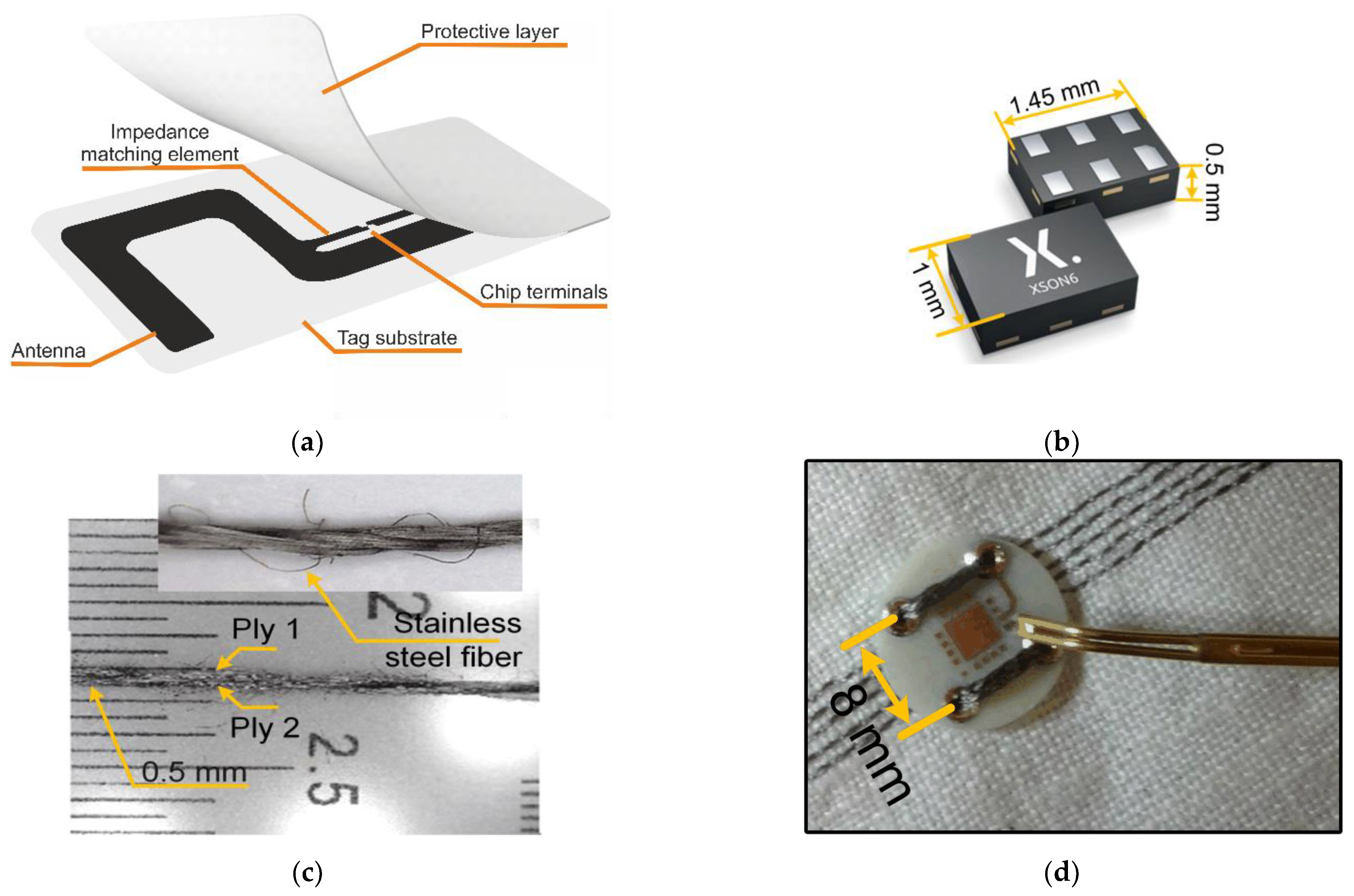
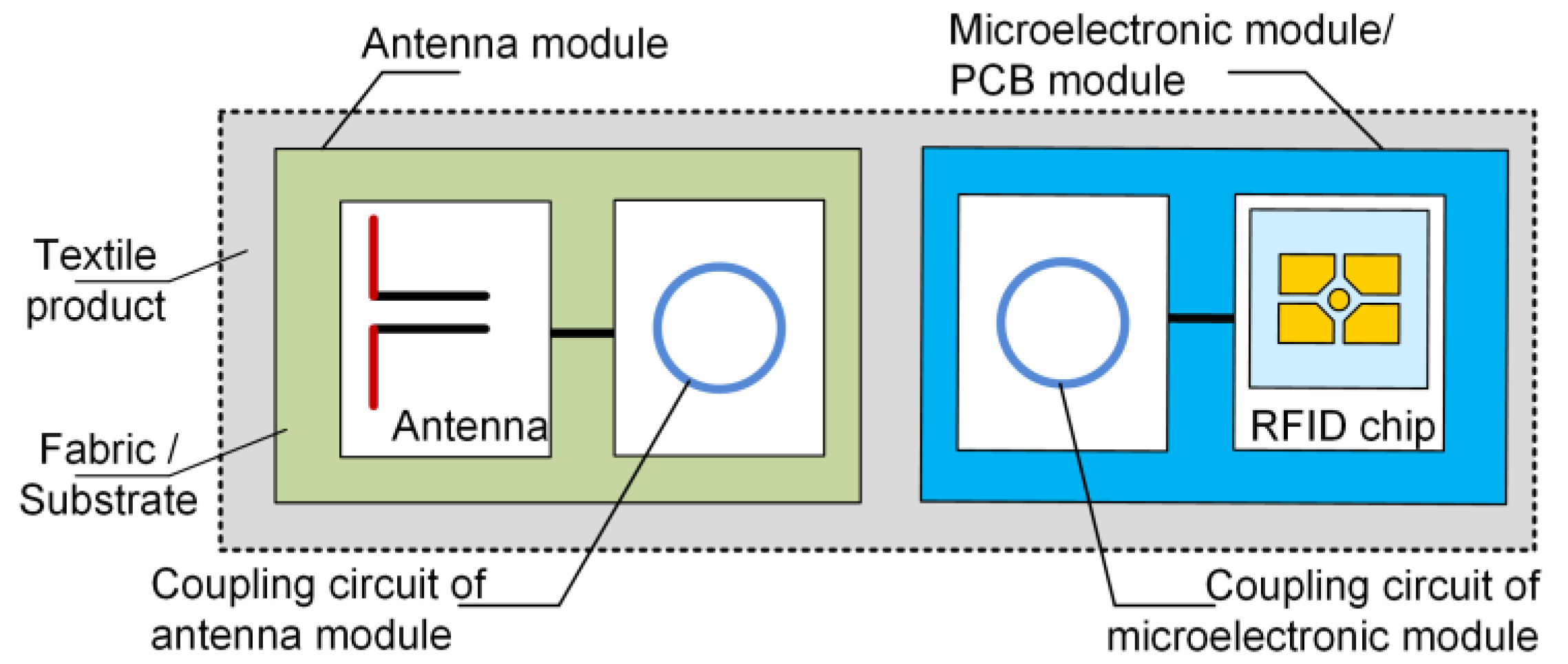
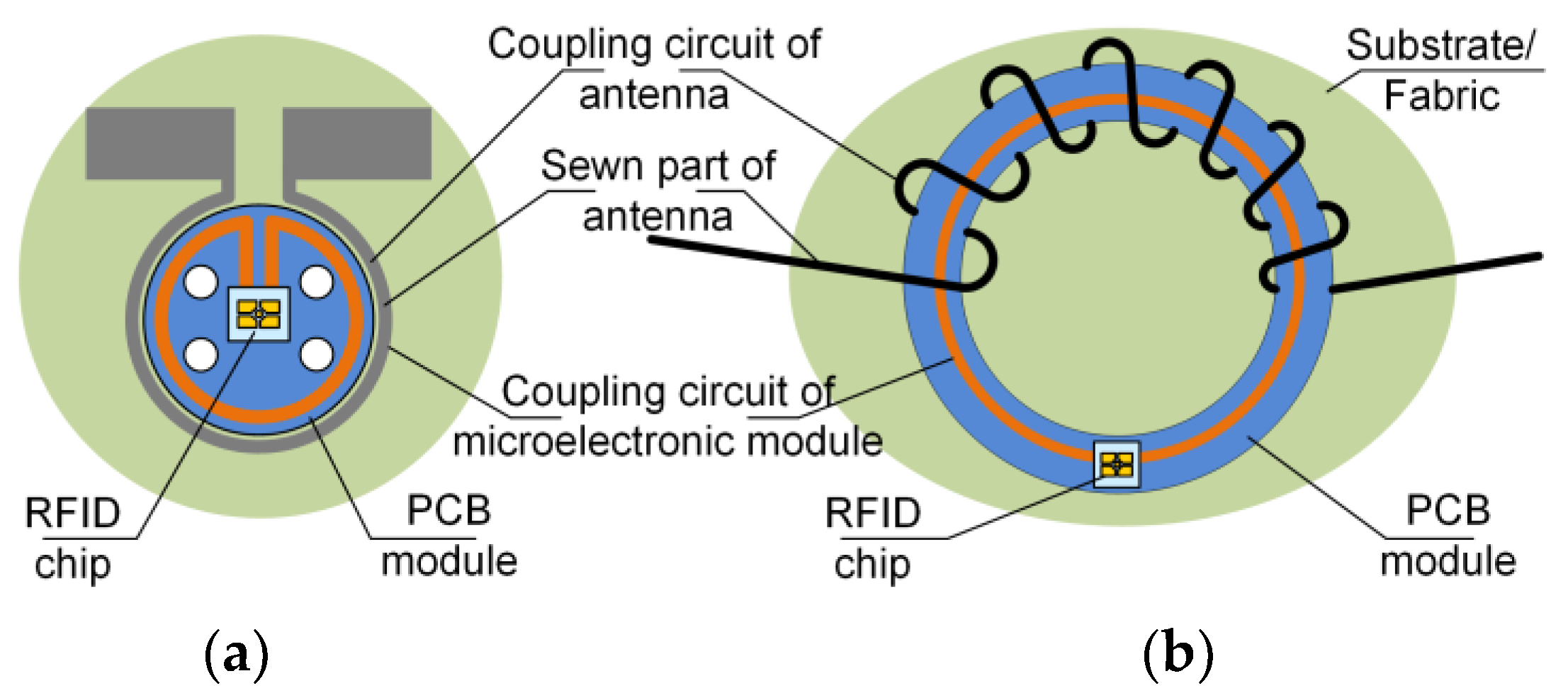
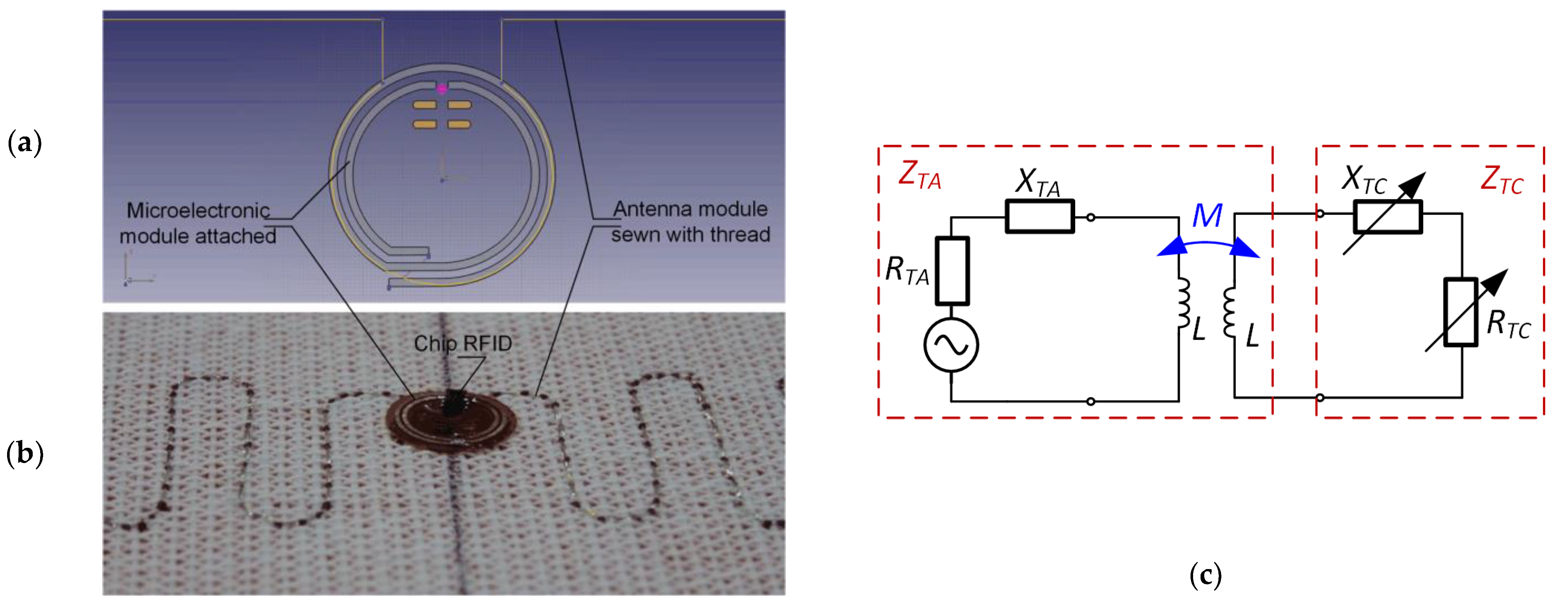
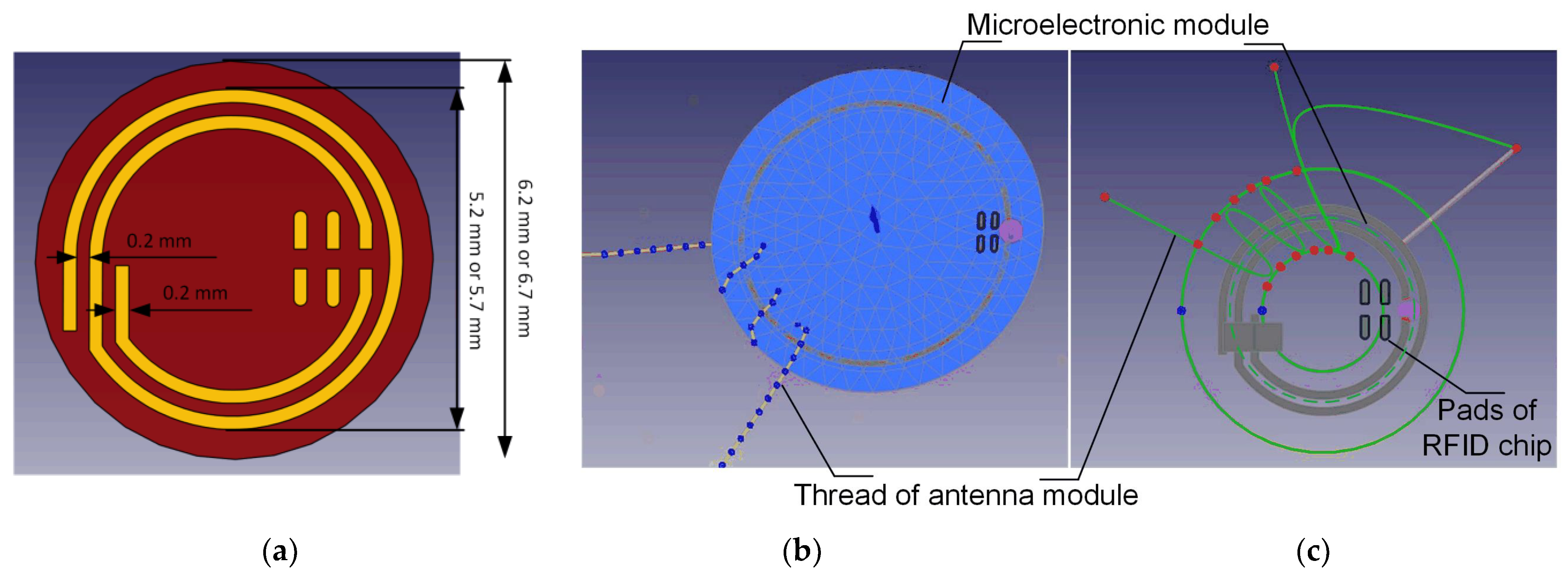






| Frequency | Impedance of Bare Chip | Impedance of Packaged Chip |
|---|---|---|
| 866 MHz | 14.5-j293 Ω | 14.8-j264 Ω |
| 915 MHz | 12.5-j277 Ω | 12.8-j248 Ω |
| 953 MHz | 12.5-j267 Ω | 12.8-j238 Ω |
| Read sensitivity/Minimum input power | −21 dBm | |
| Sample No. | Number of Turns | Read Range, cm |
|---|---|---|
| H1 | 1 | 119 |
| H2 | 2 | 176 |
| H3 | 3 | 187 |
| H4 | 4 | 107 |
| Sample No. | Length of Radiator | Read Range, cm |
|---|---|---|
| 1 | 20.5 | 54 |
| 2 | 19 | 56 |
| 3 | 18 | 111 |
| 4 | 17 | 124 |
| 5 | 16 | 187 |
| 6 | 15 | 187 |
| 7 | 14 | 156 |
| 8 | 13 | 107 |
| 9 | 12 | 43 |
Disclaimer/Publisher’s Note: The statements, opinions and data contained in all publications are solely those of the individual author(s) and contributor(s) and not of MDPI and/or the editor(s). MDPI and/or the editor(s) disclaim responsibility for any injury to people or property resulting from any ideas, methods, instructions or products referred to in the content. |
© 2023 by the authors. Licensee MDPI, Basel, Switzerland. This article is an open access article distributed under the terms and conditions of the Creative Commons Attribution (CC BY) license (https://creativecommons.org/licenses/by/4.0/).
Share and Cite
Jankowski-Mihułowicz, P.; Węglarski, M.; Pyt, P.; Skrobacz, K.; Karpiński, K. UHF Textronic RFID Transponder with Bead-Shaped Microelectronic Module. Electronics 2023, 12, 4873. https://doi.org/10.3390/electronics12234873
Jankowski-Mihułowicz P, Węglarski M, Pyt P, Skrobacz K, Karpiński K. UHF Textronic RFID Transponder with Bead-Shaped Microelectronic Module. Electronics. 2023; 12(23):4873. https://doi.org/10.3390/electronics12234873
Chicago/Turabian StyleJankowski-Mihułowicz, Piotr, Mariusz Węglarski, Patryk Pyt, Kacper Skrobacz, and Karol Karpiński. 2023. "UHF Textronic RFID Transponder with Bead-Shaped Microelectronic Module" Electronics 12, no. 23: 4873. https://doi.org/10.3390/electronics12234873
APA StyleJankowski-Mihułowicz, P., Węglarski, M., Pyt, P., Skrobacz, K., & Karpiński, K. (2023). UHF Textronic RFID Transponder with Bead-Shaped Microelectronic Module. Electronics, 12(23), 4873. https://doi.org/10.3390/electronics12234873











